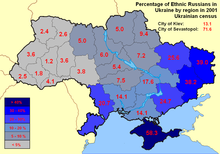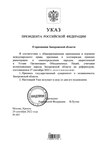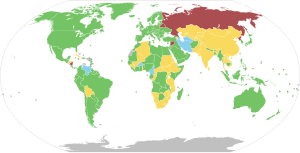
Zaporizhzhia Oblast, commonly referred to as Zaporizhzhia (Запоріжжя), is an oblast (region) in south-east Ukraine. Its administrative centre is Zaporizhzhia. The oblast covers an area of 27,183 square kilometres (10,495 sq mi), and has a population of 1,638,462.

In Russia, the oblasts are 46 administrative territories; they are one type of federal subject, the highest-level administrative division of Russian territory.

Kherson Oblast, also known as Khersonshchyna, is an oblast (province) in southern Ukraine. It is located just north of Crimea. Its administrative center is Kherson, on the northern or right bank of the Dnieper river, which bisects the oblast. The oblast has an area of 28,461 km2 and a population of 1,001,598. It is considered the 'fruit basket' of the country, as much of its agricultural production is dispersed throughout the country, with production peaking during the summer months.

The Luhansk People's Republic or Lugansk People's Republic is a republic of Russia in the occupied parts of eastern Ukraine's Luhansk Oblast, with its capital in Luhansk. The LPR was proclaimed by Russian-backed paramilitaries in 2014, and it initially operated as a breakaway state until it was annexed by Russia in 2022. The entire territory of LPR is viewed as sovereign territory of Ukraine by nearly all UN member states.

Russian irredentism refers to territorial claims made by the Russian Federation to territories that were historically part of the Russian Empire and the Soviet Union, which Russian nationalists refer to as the "Russian world". It seeks to politically incorporate ethnic Russians and Russian speakers living in neighbouring territories outside Russia's modern-day borders. This ideology has been significantly defined by the regime of Vladimir Putin, who has governed the country since 1999.
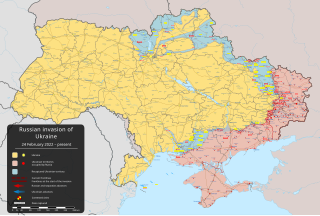
The Russian-occupied territories of Ukraine are areas of Ukraine that are currently controlled by Russia in the course of the Russo-Ukrainian War. In Ukrainian law, they are defined as the "temporarily occupied territories of Ukraine".

Leonid Ivanovich Pasechnik is a Ukrainian-born politician who has served as Head of the Luhansk People's Republic (LPR) since 2017. He holds the position in acting capacity ever since the illegal and unrecognized Russian annexation of Donetsk, Kherson, Luhansk and Zaporizhzhia oblasts in 2022. Pasechnik had previously held office as the LPR's Minister of State Security from 2014 to 2018.

Since the dissolution of the Soviet Union in 1991, Russia has been involved in territorial disputes with a number of other post-Soviet states. These disputes are primarily an aspect of the post-Soviet conflicts, and have led to some countries losing parts of their sovereign territory to what a large portion of the international community designates as a Russian military occupation. As such, these lands are commonly described as Russian-occupied territories, regardless of what their status is in Russian law. The term is applied to Georgia, Moldova, and Ukraine.
2022 in Russia is the 31st year of the Russian Federation.

Donetsk People's Republic–Russia relations were bilateral relations between Russia and the Donetsk People's Republic (DPR). The DPR is widely internationally unrecognized, with most of the international community regarding the DPR as a Russian military occupation of a portion of Ukraine's Donetsk Oblast. The DPR was annexed by Russia on 30 September 2022; the DPR authorities willingly acceded to Russia, and the annexation is widely internationally unrecognized. From April 2014 to September 2022, the DPR portrayed itself as an independent state, and it was widely regarded as a puppet state of Russia by the international community.
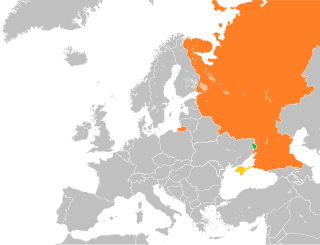
Luhansk People's Republic–Russia relations were bilateral relations between Russia and the Luhansk People's Republic (LPR). The LPR is widely internationally unrecognized, with most of the international community regarding the LPR as a Russian military occupation of a portion of Ukraine's Luhansk Oblast. The LPR was annexed by Russia on 30 September 2022; the LPR authorities willingly acceded to Russia, and the annexation is widely internationally unrecognized. From April 2014 to September 2022, the LPR portrayed itself as an independent state, and it was widely regarded as a puppet state of Russia by the international community.
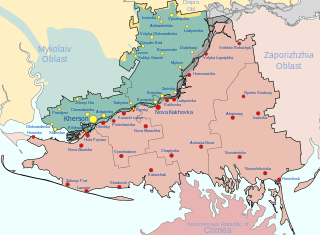
The Russian occupation of Kherson Oblast is an ongoing military occupation of Ukraine's Kherson Oblast by Russian forces that began on 2 March 2022 during the Russian invasion of Ukraine as part of the southern Ukraine campaign. It was administrated under a Russian-controlled military-civilian administration until 30 September 2022, when it was illegally annexed to become an unrecognized federal subject of Russia.
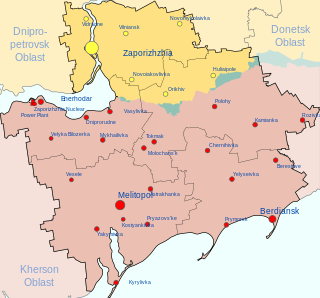
The Russian occupation of Zaporizhzhia Oblast is an ongoing military occupation of Ukraine's Zaporizhzhia Oblast by Russian forces that began on 24 February 2022 during the Russian invasion of Ukraine as part of the southern Ukraine campaign. It was administrated under a Russian-controlled military-civilian administration until 30 September 2022, when it was illegally annexed to become an unrecognized federal subject of Russia.

The Russian occupation of Mykolaiv Oblast is an ongoing military occupation of Ukraine's Mykolaiv Oblast by Russian forces during the Russian invasion of Ukraine as part of the southern Ukraine campaign. The Russian-installed occupation regime was called the "Nikolaev military-civilian administration".
In late September 2022, in the context of the Russian invasion of Ukraine, Russian-installed officials in Ukraine staged so-called referendums on the annexation of occupied territories of Ukraine by Russia. They were widely described as sham referendums by commentators and denounced by various countries. The validity of the results of the referendums has been accepted by North Korea, and no other sovereign state.
This timeline of the Russian invasion of Ukraine covers the period from 29 August 2022, when Ukraine's Kherson counteroffensive started, to 11 November 2022 when Ukrainian troops retook Kherson. In between, Ukraine launched a successful counteroffensive in Kharkiv Oblast. Starting in October, Russia began a campaign of massive strikes against Ukrainian infrastructure.
This is a list article about flags that have been used by pro-Russian separatists in Ukraine and in areas occupied by Russia and Russian-controlled forces during the Russo-Ukrainian War.

United Nations General Assembly Resolution ES‑11/4 is the fourth resolution of the eleventh emergency special session of the United Nations General Assembly, adopted on 12 October 2022, following Resolution ES-11/3 which was adopted on 7 April 2022.

The following outline is provided as an overview of and topical guide to the Russo-Ukrainian War:

